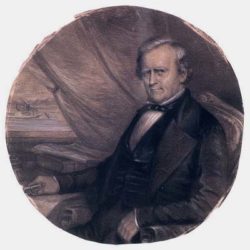Shreve Town Company
The Shreve Town Company was a business venture that led to the establishment of what is today known as Shreveport, the largest city in northwest Louisiana.
This entry is 7th Grade level View Full Entry

Wikimedia Commons
Henry Miller Shreve, illustrated late in life by George d'Almaine.
Many believe that the city of Shreveport, Louisiana, was founded by Captain Henry Miller Shreve. Captain Shreve was hired by the US government in the 1830s to clear the Red River of a logjam known as the Great Raft, but he was never a resident of the city. In truth the city of Shreveport was founded as a for-profit business venture by a group of seven partners. Captain Shreve was part of this group. The city that was founded by this group became the largest in northwest Louisiana.
How was Shreve Town (later Shreveport) founded?
The Shreve Town Company was established during a meeting held on May 24, 1836. Bushrod Jenkins, Captain Shreve, James Belton Pickett, Thomas Taylor Williamson, and Angus McNeill were present at this meeting.
Under the terms of the Caddo Indian Treaty of 1835, interpreter Larkin Edwards had received a large parcel of land. Edwards sold 640 acres of this land to McNeill for $5,000. Fifteen weeks after the sale was finalized, James Belton Pickett suggested that the land be used to create a planned city that ultimately became the location of what is now downtown Shreveport.
McNeill suggested either establishing the new town on the bluffs near the Texas Trail, where James Huntington Cane and William Smith Bennett operated a store, or on the bluffs above Wright Island, where Jim Coates operated a store and Coates Bluff had been established. On May 27, 1836, the newly formed Shreve Town Company met at Cane and Bennett’s store, and the two became part of the company, as did Thomas Sturges Sprague, an attorney from Natchez, Mississippi. The six non-landholding partners paid McNeill a total of $4,166.66 for their shares of the company. McNeill was elected president, and Jenkins was elected treasurer. The venture was named in recognition of Captain Shreve, whose work clearing the massive logjam in the Red River made the settlement of northwestern Louisiana possible.
Captain Shreve hired E. D. Hobbs of Louisville, Kentucky, to draw up a map for the planned community, which would be situated on the upper bluffs where Cane and Bennett’s store was located.
The town site, as surveyed, was eight streets wide and eight streets deep. It ran from Cross Bayou to the north to Silver Lake to the south and from the Red River to the east to bottomlands to the west. It occupied a ridge of high ground that wouldn’t be prone to flooding but still allowed easy access to the river. It also crossed the Texas Trail, an important overland route to the west.
Who profited from the founding of Shreveport?
In February 1837 McNeill transferred ownership of his land to Shreve Town Company. He later argued that the other members of the company had tricked him into transferring his land to the corporation. The others denied this, but the disagreement led to conflict between members of the company. Nevertheless, the business venture was successful, and Shreve Town made its members and their heirs a substantial profit through the sale of lots to new residents and businesses.
In 1838 Shreve Town became Shreveport, and the next year the new town became the seat of the newly created Caddo Parish. Not all members of the Shreve Town Company lived to see its success within their lifetimes. Bennett died in 1837 before the town site was fully cleared. Sprague died the following year. Pickett died in 1842 while on a business trip to Kentucky, and Cane died suddenly in 1844. Two years later Jenkins died. Shreve himself died in St. Louis in 1851 at the age of sixty-six. Only Williamson and McNeill lived to enjoy their old age.
Mary Bennett Cane gained the most from the Shreve Town Company’s profits. She was first married to Bennett, then to Cane, and survived both men. She inherited the shares of her two late husbands and bought substantial tracts of land in Caddo and Bossier Parishes, as did her friend, Pickett’s widow, Pauline de Graffenried Pickett.
